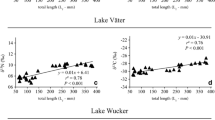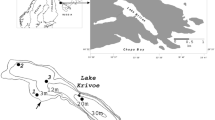Abstract
Tissue stable isotopes and biochemical condition were compared in two populations of white perch, Morone americana, residing in a Phragmites australis-dominated tidal salt marsh and adjacent open waters of Haverstraw Bay, in the Hudson River estuary, USA. As reported previously for other taxa in this system, stable isotope composition of M. americana was influenced by the dominant vegetation present, in this case a near monoculture of P. australis and other C3 vegetation, mainly deciduous trees, that lined the immediate upland shoreline of the marsh. However, all three stable isotopes, δ13C, δ15N, and δ34S, differed significantly between the two populations, with all three parameters displaying enrichment in the open water collections. Both fish populations exhibited the expected allometric relationships among mass components (total protein, total lipids, dry weight) but energy reserves in the form of triacylglycerols and total lipids were significantly greater in the Haverstraw Bay population. These results were interpreted to not only be a function of fish size but also to originate from differences in habitat quality at the two locations.







Similar content being viewed by others
References
Able KW, Fahay MP (1998) The first year in the life of estuarine fishes in the Middle Atlantic Bight. Rutgers University Press, New Brunswick
Ackman RG (1980) Fish lipids, Part I. In: Connell JJ (ed) Advances in fish science and technology. Fishing News Books, Oxford, pp 86–103
Ackman RG, Eaton CA (1976) Variations in fillet lipid content and some percent lipid-iodine value relationships for large winter Atlantic herring from south-eastern Newfoundland. Journal Fisheries Research Board of Canada 33:634–638
Conover DO, Schultz ET (1997) Natural selection and adaptation of growth rate: what are the tradeoffs? In: Hambers RC, Tripple EA (eds) Early life history and recruitment in fish populations. Chapman and Hall, London, pp 305–332
Currin CA, Wainright SC, Able KW, Weinstein MP, Fuller CM (2003) Determination of food web support and trophic position of the mummichog, Fundulus heteroclitus, in New Jersey smooth cordgrass (Spartina alterniflora), common reed (Phragmites australis), and restored salt marshes. Estuaries 26(2B):495–510
Folch J, Lees M, Sloan-Stanley GH (1957) A simple method for the isolation and purification of lipids from animal tissues. Journal of Biological Chemistry 226:497–509
Haines EB (1979) Interactions between Georgia salt marshes and coastal waters: a changing paradigm. In: Livingston RJ (ed) Ecological processes in coastal and marine systems. Plenum, New York, pp 35–46
Heintz RA, Bonita DN, Hudson JH, Larsen M, Holland L (2004) Marine subsidies in freshwater: effects of salmon carcasses on lipid class and fatty acid composition of juvenile coho salmon. Transactions of the American Fisheries Society 133:559–567
Henderson RJ, Tocher DR (1987) The lipid composition and biochemistry of freshwater fish. Progress in Lipid Research 26:281–347
Hurst TP (2007) Causes and consequences of winter mortality in fishes. Journal of Fish Biology 71:315–345
Hurst TP, Convover DO (2003) Seasonal and interannual variation in the allometry of energy allocation in juvenile striped bass. Ecology 84:2260–3369
Hurst TP, Schultz ET, Conover DO (2000) Seasonal energy dynamics of young of the year Hudson River striped bass. Transactions of the American Fisheries Society 129:145–157
Kneib RT (2003) Bioenergetic and landscape considerations for scaling expectations of nekton production from intertidal marshes. Marine Ecology Progress Series 264:279–296
Lankford TE, Targett TE (1994) Selective predation by juvenile weakfish: post-consumptive constraints on energy maximization and growth. Ecology 1997:1049–1061
Litvin SY, Weinstein MP (2003) Life history strategies of estuarine nekton: the role of marsh macrophytes, microphytobenthos and phytoplankton in the trophic spectrum. Estuaries 26(2B):553–653
Litvin SY, Weinstein MP (2004) Multivariate analysis of stable isotope ratios to infer movements and utilization of estuarine organic matter by juvenile weakfish (Cynoscion regalis). Canadian Journal of Fisheries and Aquatic Sciences 61:1851–1861
Lochman SE, Maillet GL, Taggart CT, Frank KT (1996) Effects of gut contents and lipid degradation on condition measures in larval fish. Marine Ecology Progress Series 134:27–35
Lochmann SE, Ludwig GM (2003) Relative triacylglycerol and morphometric measures of condition in sunshine bass fry. North American Journal of Aquaculture 65:191–2003
Lochmann SE, Maillet GL, Frank KT, Taggart CT (1995) Lipid class composition as a measure of nutritional condition in individual larval Atlantic cod (Gadus morhua). Canadian Journal of Fisheries and Aquatic Sciences 52:1294–1306
Montalto FA, Steenhuis TS, Parlange JY (2005) The hydrology of Piermont Marsh, a reference for tidal marsh restoration in the Hudson River estuary, New York. Journal of Hydrology 316:108–128
Montevecchi WA, Piatt J (1984) Composition and energy contents of mature inshore spawning capelin (Mallotus villosus): implications for seabird predators. Comparative Biochemistry and Physiology 78A:15–20
Nemerson DA (2001) Geographic, seasonal and ontogenetic patters in the trophic dynamics of five fish species of Delaware Bay, USA. Dissertation, Rutgers University
Osgood DT, Yozzo DJ, Chambers RM, Pianka S, Lewis J, LePage C (2006) Patterns of habitat utilization by resident nekton in Phragmites and Typha marshes on the Hudson River Estuary, New York. American Fisheries Society Symposium 51:151–173
Parrish CC (1987) Separation of aquatic lipid classes by chromarod thin-layer chromatography with measurement by Iatroscan flame ionization detection. Canadian Journal of Fisheries and Aquatic Sciences 44:722–731
Post JR, Lee JA (1996) Metabolic ontogeny of teleost fishes. Canadian Journal of Fisheries and Aquatic Sciences 53:910–923
Post JR, Parkinson EA (2001) Energy allocation strategy in young fish: allometry and survival. Ecology 82:1040–1051
Post JR, Johannes MRS, McQueen DJ (1997) Evidence of density dependent cohort splitting in age-0 yellow perch, Perca flavescens: potential behavioral mechanisms and population level consequences. Canadian Journal of Fisheries and Aquatic Science 54:867–875
Post DM, Layman CA, Arrington DA, Takimoto G, Quiattrochi J, Montana CG (2007) Getting to the fat of the matter: models, methods and assumptions for dealing with lipids in stable isotope analyses. Oecologia 152:179–189
Ross DA, Love RM (1979) Decrease in the cold-store flavor developed by frozen fillets of starved cod (Gadus morhua L.). Journal of Food Technology 14:115–122
Schultz ET, Conover DO (1997) Latitudinal differences in somatic energy storage: adaptive responses to seasonality in an estuarine fish (Atherinidae: Menidia menidia). Oecologia 109:516–529
Schultz ET, Conover DO (1999) The allometry of energy reserve depletion: test of a mechanism for size dependent winter mortality. Oecologia 119:474–483
Shulman GE, Love RM (1999) The biochemical ecology of marine fish. Advances in Marine Biology, vol 36. Academic, New York
Shuter BJ, Post JR (1990) Climate, population viability, and the zoogeography of temperate fishes. Transactions of the American Fisheries Society 119:314–336
Slotte A (1999) Differential utilization of energy during wintering and spring-spawning migration in Norwegian spring spawned herring. Journal of Fish Biology 54:338–355
Smith SM, Hoff JG Jr, O’Neil SP, Weinstein MP (1985) Community and trophic organization of nekton utilizing shallow marsh habitats, York River Estuary, Virginia. Fishery Bulletin, US 82:455–467
Sogard SM, Spencer ML (2004) Energy allocation in juvenile sablefish: effects of temperature, ration and body size. Journal of Fish Biology 64:726–738
SPSS (2007) SPSS® Version 12.0 for Windows® (SYSTAT) [computer program]. SPSS, Chicago
Sutton SG, Bult TP, Haedrich RL (2000) Relationships among fat weight, body weight, water weight, and condition factors in wild Atlantic salmon parr. Transactions of the American Fisheries Society 129:527–538
Wainright SA, Weinstein MP, Able KW, Currin CA (2000) Relative importance of benthic microalgae, phytoplankton and detritus of smooth cordgrass (Spartina) and the common reed (Phragmites) to brackish marsh food webs. Marine Ecology Progress Series 200:77–91
Walters CJ, Juanes F (1993) Recruitment limitation as a consequence of natural selection for use of restricted feeding habitats and predation risk taking by juvenile fishes. Canadian Journal of Fisheries and Aquatic Sciences 50:2058–2070
Weinstein MP (1979) Shallow marsh habitats as primary nurseries for fishes and shellfish, Cape Fear River, North Carolina. Fishery Bulletin, US 77:339–357
Weinstein MP, Litvin SY, Bosley KI, Fuller CM, Wainright SC (2000) The role of tidal salt marsh as an energy source for juvenile marine transient finfishes: a stable isotope approach. Transactions of the American Fisheries Society 129:797–810
Weinstein MP, Litvin SY, Guida VG (2005) Consideration of habitat linkages, estuarine landscapes and the trophic spectrum in wetland restoration design. Journal of Coastal Research, Special Issue 40:51–63
Weinstein MP, Litvin SY, Guida VG (2009a) Essential fish habitat and wetland restoration success: a Tier III approach to the biochemical condition of the common mummichog, Fundulus heteroclitus in common reed, Phragmites australis and smooth cordgrass, Spartina alterniflora dominated salt marshes. Estuaries and Coasts 32:1011–1022
Weinstein MP, Litvin SY, Guida VG (2009b) Is global climate change influencing the overwintering distribution of weakfish (Cynoscion regalis, Bloch & Schneider, 1801)? Journal of Fish Biology 75:693–698
Winogrand HG, Kiviat E (1997) Invasion of Phragmites australis in the tidal marshes of the Hudson River. Section VI. In: Neider WC, Waldman JR (eds) Final report of the Tibor T. Polgar Fellowship Program, 1996, ed., 29th edn. Hudson River Foundation, New York, pp 73–89
Yuneva V, Shulman GE, Shcepkina AM (1991) The dynamics of lipid characteristics in horse-mackerel during swimming. Zhurnal Evolutsionnoy Biochimmi i Physiologii 27:730–735
Acknowledgements
We thank G. Sobotka for assistance in the laboratory, and P. Rowe, A. Avizius, and S. Strauss for their help in the field. This study was supported by United States Environmental Protection Agency, grant no. X7-97280601, and is posted as contribution # ISS 2010-0025, Institute for Sustainability Studies, Montclair State University.
Author information
Authors and Affiliations
Corresponding author
Rights and permissions
About this article
Cite this article
Weinstein, M.P., Litvin, S.Y. & Guida, V.G. Stable Isotope and Biochemical Composition of White Perch in a Phragmites Dominated Salt Marsh and Adjacent Waters. Wetlands 30, 1181–1191 (2010). https://doi.org/10.1007/s13157-010-0102-2
Received:
Accepted:
Published:
Issue Date:
DOI: https://doi.org/10.1007/s13157-010-0102-2




